“The sound is not a “picture of acoustic instruments being amplified”, it is like you were sitting close to the instruments.”
– Antoine Blanchard, FoH of Renan Luce
Interview with Antoine Blanchard, FOH of French top Artist Renan Luce
In July, the acclaimed French artist Renan Luce had the first concert of the tour to promote his new album ”Renan Luce”. The tour continued in September 2019 in France. Renan’s FOH since 2005, Antoine Blanchard, had reached out to REMIC MICROPHONES months before the first concerts as the tour includes a string section for which he wanted a very natural and full sound. We bring this interview with FOH Antoine Blanchard to share his reflections about the use of REMIC MICROPHONES for the Renan Luce tour.
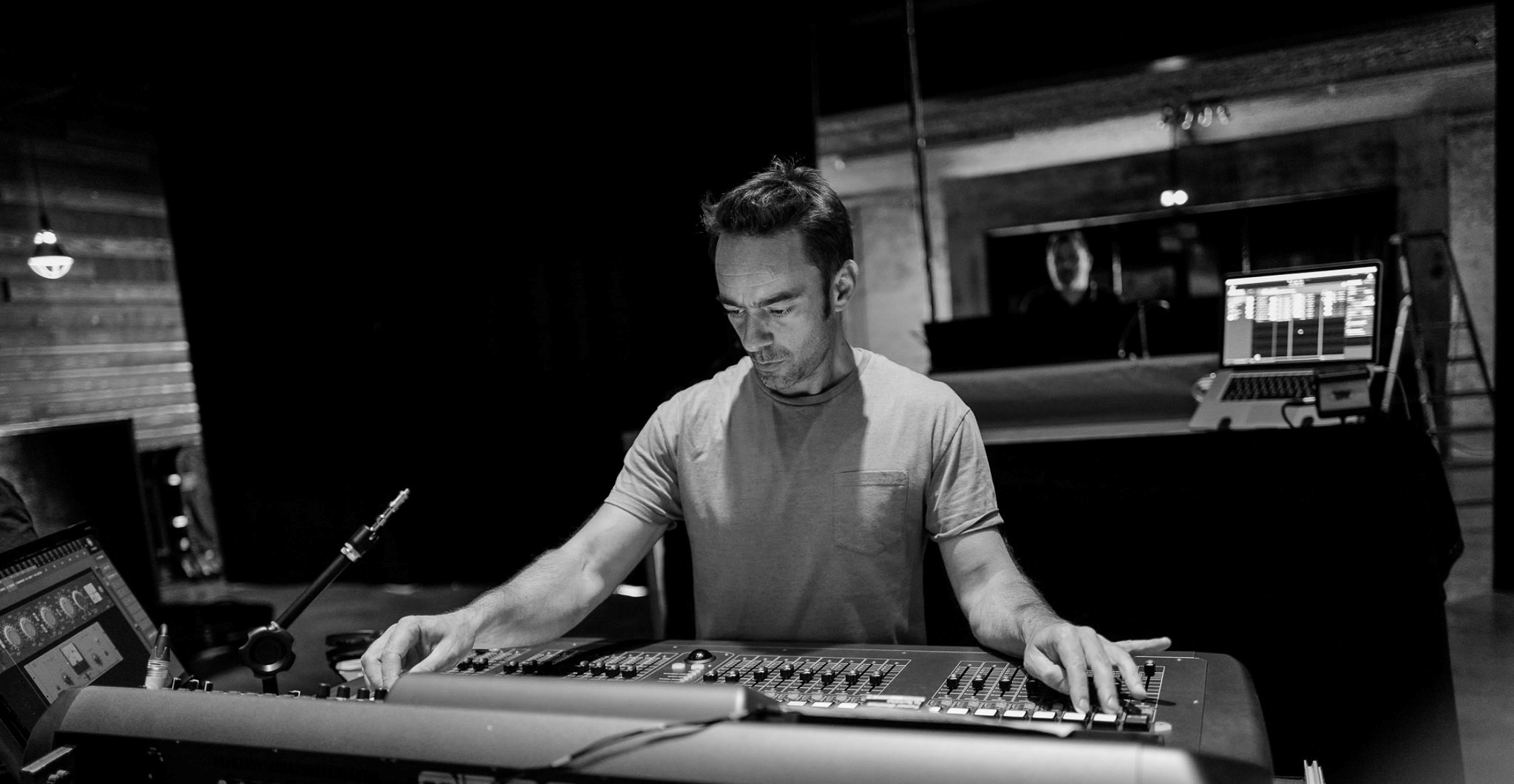
Antoine Blanchard, sound engineer of Renan Luce
Photographer: Jeff Genie
In which genre would you place the music of Renan Luce?
Renan Luce’s music could be described as songs or more specifically “chanson” in the particular French tradition, with a mix of folk, pop and jazz genres. For his new album, he wanted the music to be orchestral, in the way the great Jacques Brel or Gilbert Bécaud have done it during the 60’s. Renan wrote and composed the whole album with the help of a guitar or a piano, and then worked with composer Romain Trouillet for the arrangements.
What kind of instrumentation do the arrangements include on this tour?
This new record features a 40 piece orchestra and Romain Trouillet made a great work at reducing the scores for the smaller orchestra that has been hired for the tour, so the instruments are: 3 first violins, 2 second violins, 2 violas, 2 cellos, 1 French horn, 1 bassoon and 1 flute. In addition, there is a trio consisting of drums and percussion / double bass / piano. Renan Luce plays a nylon (Brazilian style) acoustic guitar and is of course the lead singer. In total, there are 16 musicians on stage.
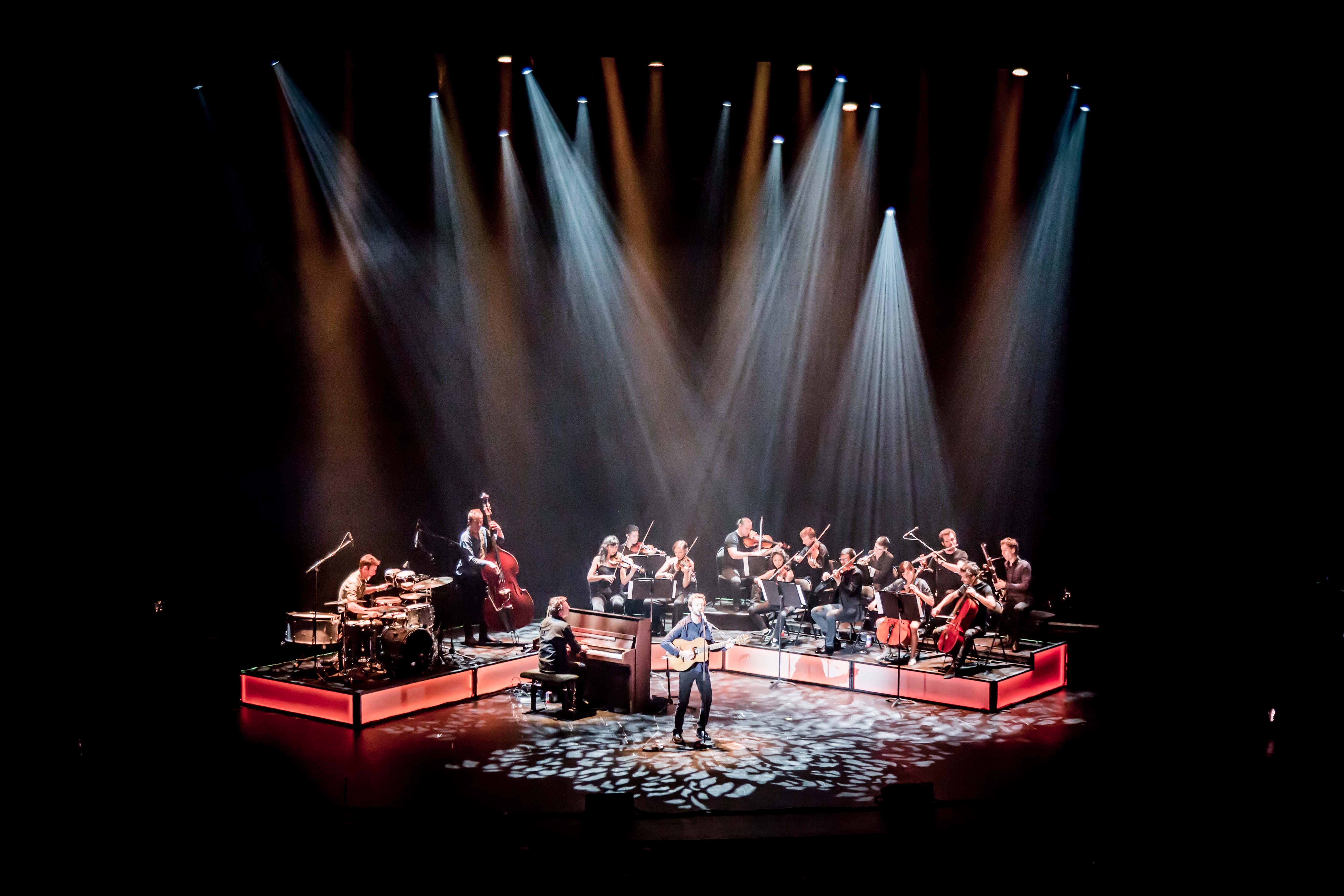
Renan Luce and Le Sinfonia Pop Orchestra
Photographer: Rod Maurice, www.facebook.com/lamedeson
What were your concerns about the use of microphones for the string section on the tour?
My concerns for the string section were being able to deliver a full and natural (but amplified) orchestral sound without feedback, in venues with the audience capacity ranging from 400 to 1500 people. I wanted to reach sound pressure levels between 83 to 93 dBs (LAeq 15 min).
Firstly, we wanted a very natural sound, true to the instruments. We wanted to match – as much as possible in a sound reinforcement realm – the strings sound of the album released, which is beautiful, and puts the orchestra very forward in the mix. So, it had to be microphones, not pickups. But aesthetically, we did not want the stage to look like a forest of microphone stands either.
I was looking for a close-miking solution of the highest quality and safety (avoiding potential audio accidents due to hazardous mounting of the mics) and wanted try out microphones with an omnidirectional polar pattern for this purpose. Microphones with omnidirectional polar pattern are free from the proximity effect, which is a known problem in a sound reinforcement situation, when you employ microphones with cardioid/hyper cardioid polar pattern, which then forces you to low cut and equalize madly, sucking the life out of the sound of the instruments.
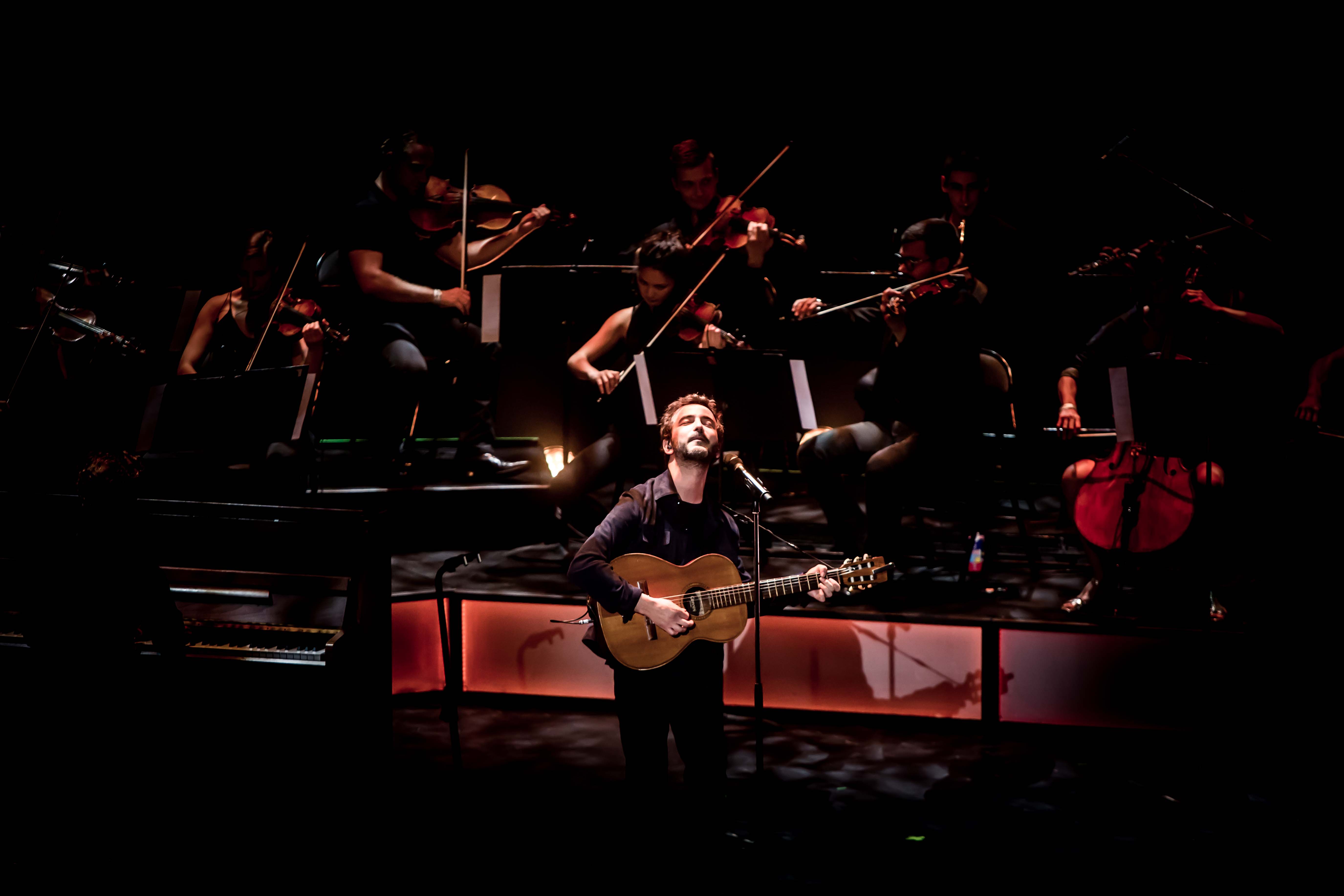
Renan Luce and Le Sinfonia Pop Orchestra
Photographer: Rod Maurice, www.facebook.com/lamedeson
How did you learn about REMIC MICROPHONES?
Through pro audio ads.
How was the process of testing and deciding, whether you found REMICs the right microphone tools for the string section?
When I took an interest at the Remic, there were no representatives in France, so I wrote an email directly to REMIC MICROPHONES in Denmark, describing the project and asking about a way for me to test the REMICs.
I had been charmed by their mounting concept and wire, but I needed to hear them and to try them with different instruments/PA/monitors configurations, and to compare them to the “usual suspects” that we habitually use for such task.
I asked some of the musicians I had worked with before if they would help me try this new type of microphones. I had the chance to have 2 double bassists, 1 cellist, 1 string quartet and two sound-engineers volunteered to run tests with me. REMIC MICROPHONES sent me a test kit with the series D5400 for double bass, C5300 for cello, and V5200 for violin all in both Studio/Live and LB Live versions.
For almost two months, I lent the REMICs to the testers to use and compare them with their own microphones during their concerts and they gave me their impressions and sound samples, when they had the chance/time to record their tests.
I also ran tests at home by multi tracking the REMICs with different instruments, microphones and pickups. I attended at a rehearsal session and show of the Symphonia Pop Orchestra, which is hired for the Renan Luce tour. Their show took place at a venue I know well, so I could feel, see and hear what was really happening with the REMICs with confidence.
This session sealed the choice in the REMICs to be the strings microphones for Renan Luce’s tour. The house engineers (whom I also know well and trust) were both positively surprised and agreed with me that the REMICs were really good. The FOH engineer immediately asked me to lend him the C5300s for a tour he had at that time and ordered one of them some days later.
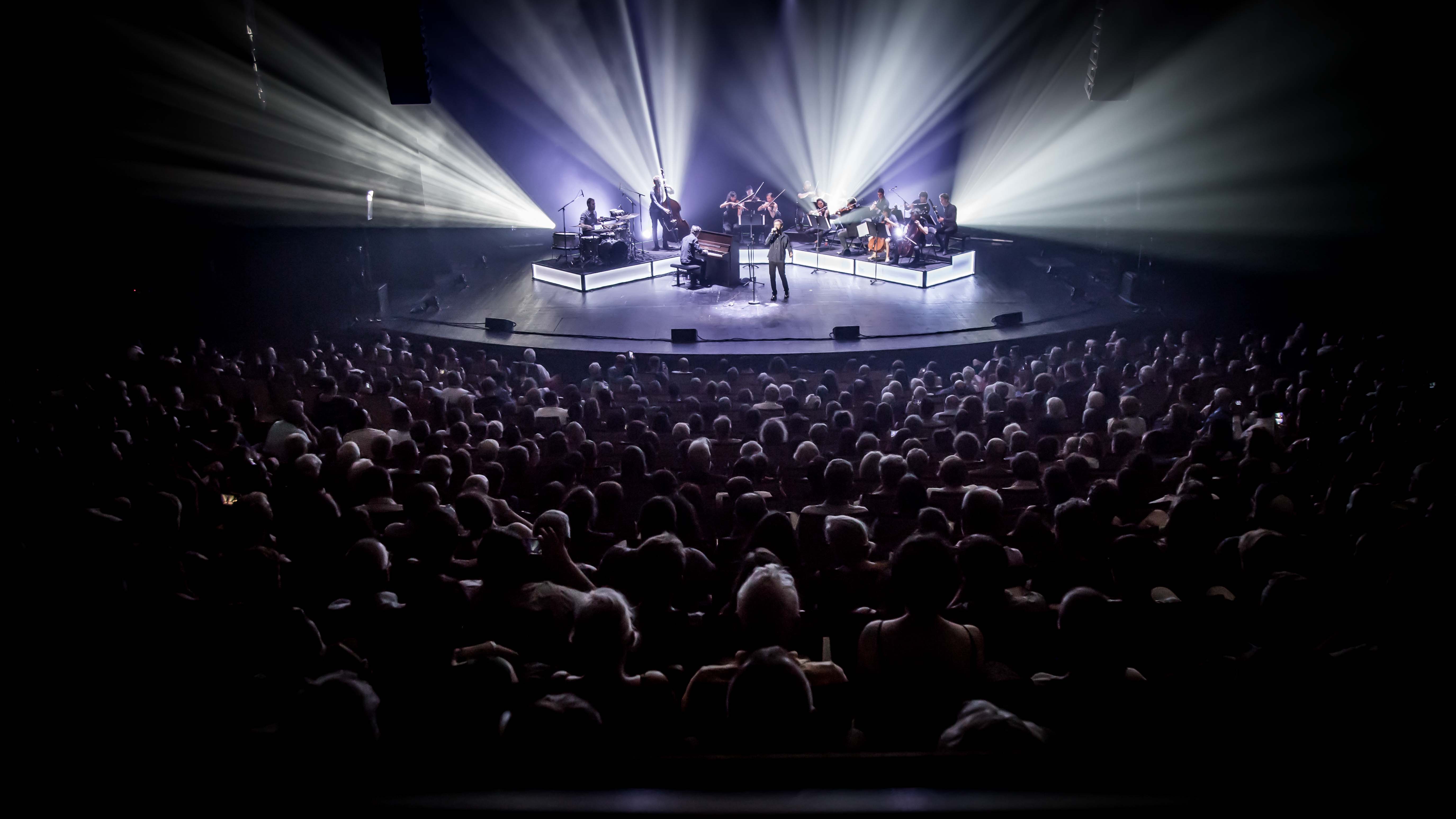
Renan Luce and Le Sinfonia Pop Orchestra
Photographer: Rod Maurice, www.facebook.com/lamedeson
Which version of the REMICs did you end up using for the show and why?
We chose to use the studio version on the whole strings section because of their sound. Our REMIC kit is: 5 x V5200 (violin), 2 x B5201 (viola), 2 x C5300 (cello) and 1 x D5400-LB (double bass).
As we are not seeking loud SPL levels and also because everybody on stage wears in-ear monitors, we can benefit from the natural sound delivered by 11 microphones with omnidirectional polar patterns (9 strings and the piano) and to me that makes a difference in sound and in the delivered emotional content compared to the usual standard hyper cardioid clip-on microphone sound. The sound is not a “picture of acoustic instruments being amplified”, it is like you were siting close to the instruments.
On the double bass, I finally choose the LB – Live version, because the double bass being near the drums, I would otherwise get too much of the drums bleeding into the bass microphone. I would have preferred the studio version for its sound, but I had to compromise.
What was the reaction of the string players, when you first presented them to the REMICs?
A big smile due to the feel of the microphone and its cable, to the super easy mounting/dismounting process and finally due to the lack of an aggressive clamp. Another big smile, when hearing a natural sound in their in-ear monitors after a very little time spent at sound-tweaking with the monitoring engineer. On the second day of rehearsals, most of the musicians asked me about their price and where to buy them. I could soon feel confidence from them in our tech team and technical choices.
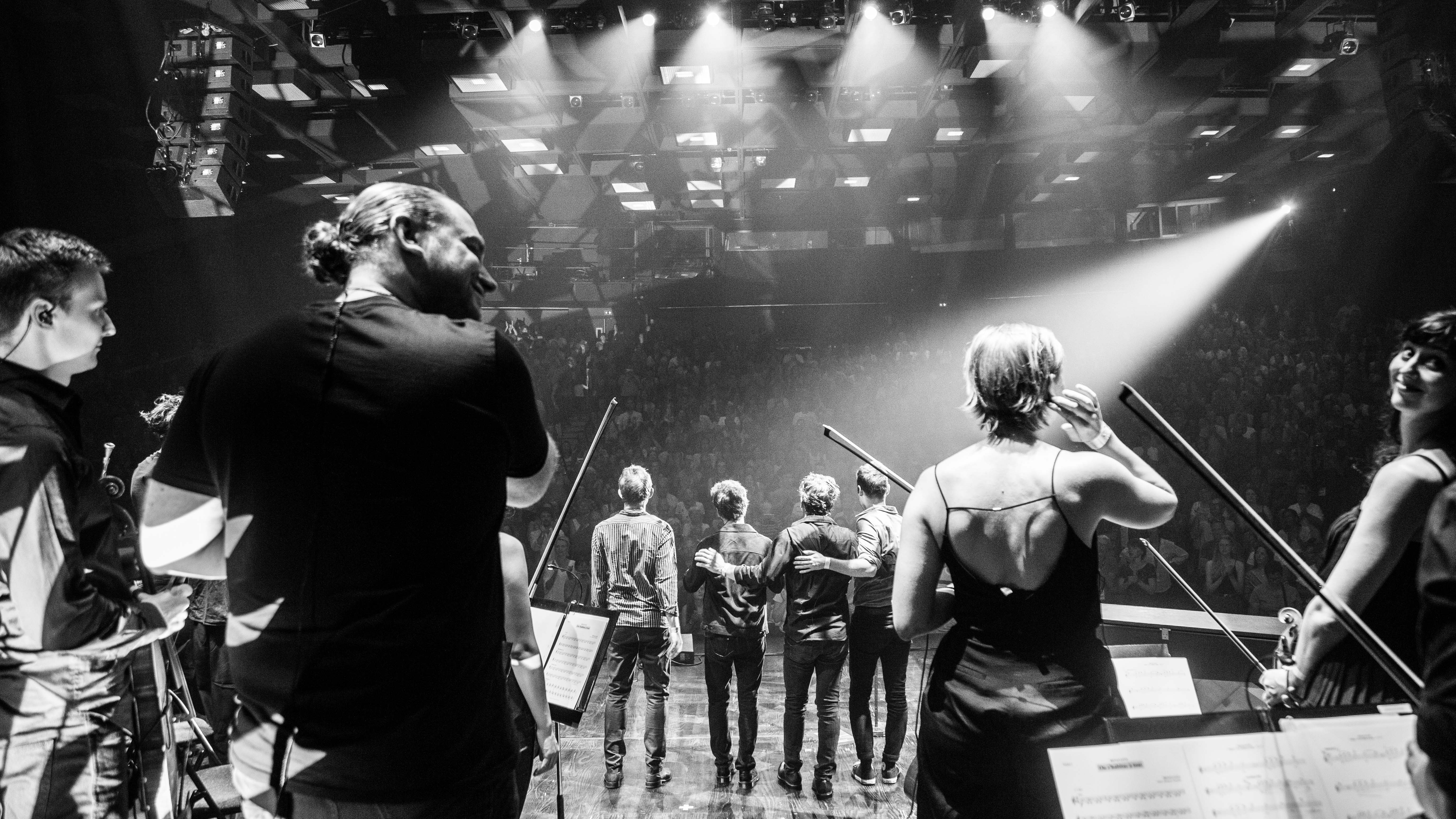
Renan Luce and Le Sinfonia Pop Orchestra
Photographer: Rod Maurice, www.facebook.com/lamedeson
What made you and the artist sure that the REMICs were the right solution for the string section?
Their natural and realistic sound and their resistance to feedback at PA average SPL levels of 83 to 96 dB (A-15 minutes). The musicians immediately loved the sound they had in their ears.
The REMICs helped save time and stress, because they sound very good, and because they free the musicians from the usual technical constraints they have to deal with, when playing amplified: fear of hitting the microphone with the bow, fear of having the microphone move or fall off during the performance, getting rid of having the mic located in their field of view, fear of cable and connector management and possible dramatic accidents occurring during the show.
As an engineer, it is a relief to feel free from potential manipulation accidents (so dangerous with 48V engaged on every channel!), and as the musicians appreciate such a smart solution, they are much more on your side, so it favors the artist-engineer partnership.
After a quick EQ setting, the director and arranger were totally satisfied with the sound too, and when I played back some samples of the rehearsal, the artist, manager, producer and musicians thought I was playing the record. They said the sound quality exceeded their expectations. So we had to admit it was the right solution!
How were the REMICs different from other microphone solutions you usually work with?
In addition to the ultra-clever mounting concept discussed above and its stressless benefits, there are some major differences:
1) The studio versions are omnidirectional, free from proximity-effect by nature, so you do not have to low-cut them that much, and that allows for more usable and natural low end content, which gives a realistic feel of the instrument being close to you.
2) They are mounted at the heart of the sound source, so they give a much more clean and original sound of the instrument, and as they are mounted under pressure between the soundboard and the fingerboard, they have a kind of pressure zone microphone behavior to them too, delivering some well-balanced vibrations of the instruments. It was a very good surprise and a big relief for me to be able to “push” the pizzicato parts that forward in the mix without a “smell” of feedback!
What is your overall impression of the chosen REMIC microphone model you are using for the Renan Luce tour?
They are very smart and of high-quality tools. Discrete, easy to mount, easy to equalize, powerful and natural sounding. They totally deserve their price, even more if you consider that they are handmade in Europe and you can benefit from a perfect support.
Anything else to add?
The REMIC crew is made of professional and kind people. They are musicians and artist-inclined people working for – and with – artists and engineers. You can easily get in touch with them, and if a problem occurs, they are really quick to react and help. Trine Thybo, their marketing officer, has been so kind and of perfect support in my researches. And having your technical questions answered directly by the microphone designer is so cool! I really appreciated this – no commercial bullshit, just true dialog – between people really involved in artistic performances and striving to solve their related technical issues. Thank you very much to REMIC MICROPHONES and Koroll Sonorisation in France for this successful partnership!
Credits:
Artist: Renan Luce
Front of House Engineer: Antoine Blanchard
Orchestra: Le Sinfonia Pop Orchestra
Production Company: Agence 3C, Christophe Bosq
Agent: Agence Gloria, Jeff Genie
Photographer: Rod Maurice, www.facebook.com/lamedeson
Photographer of the portrait of Antoine Blanchard: Jeff Genie
